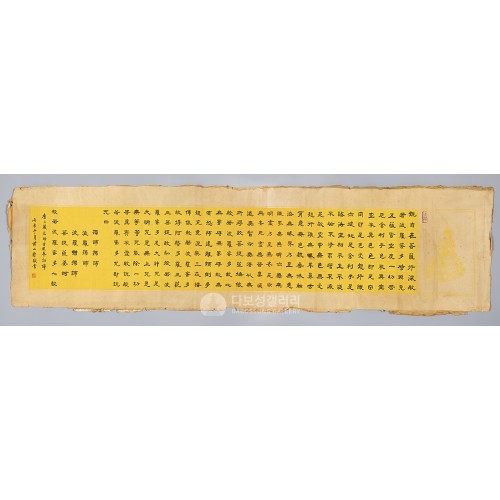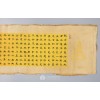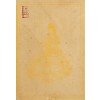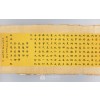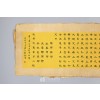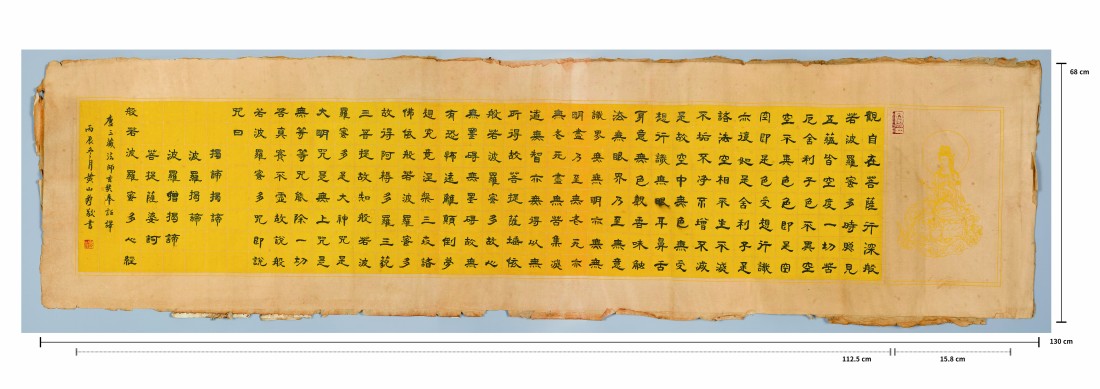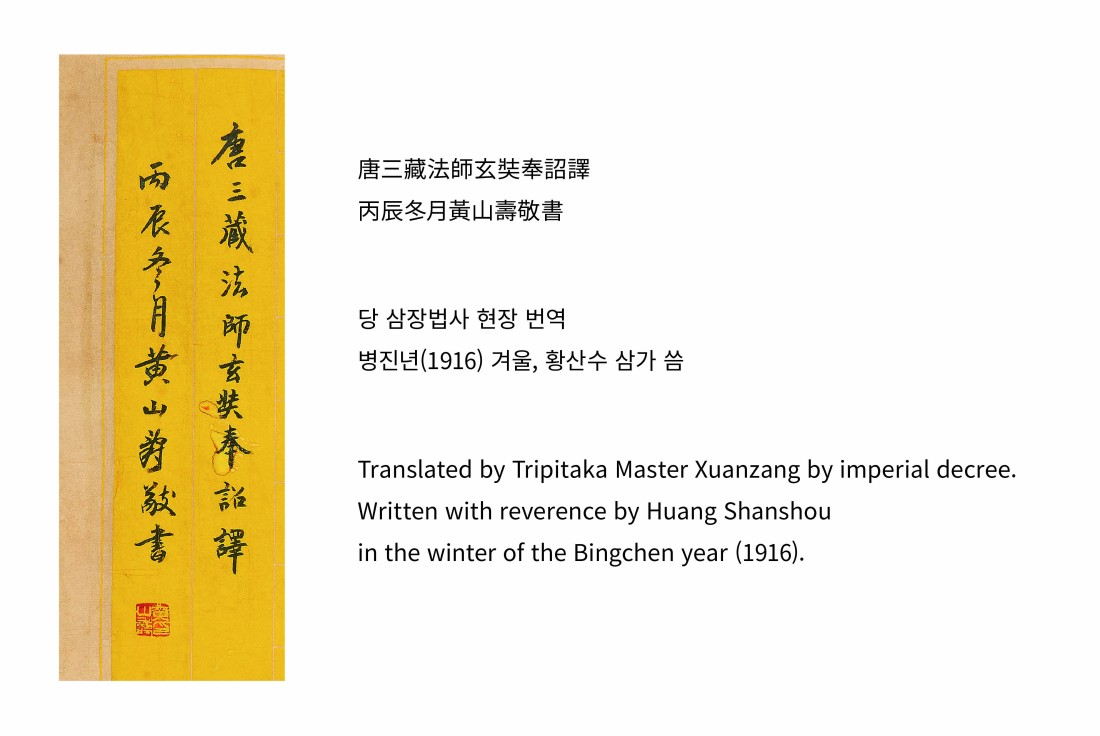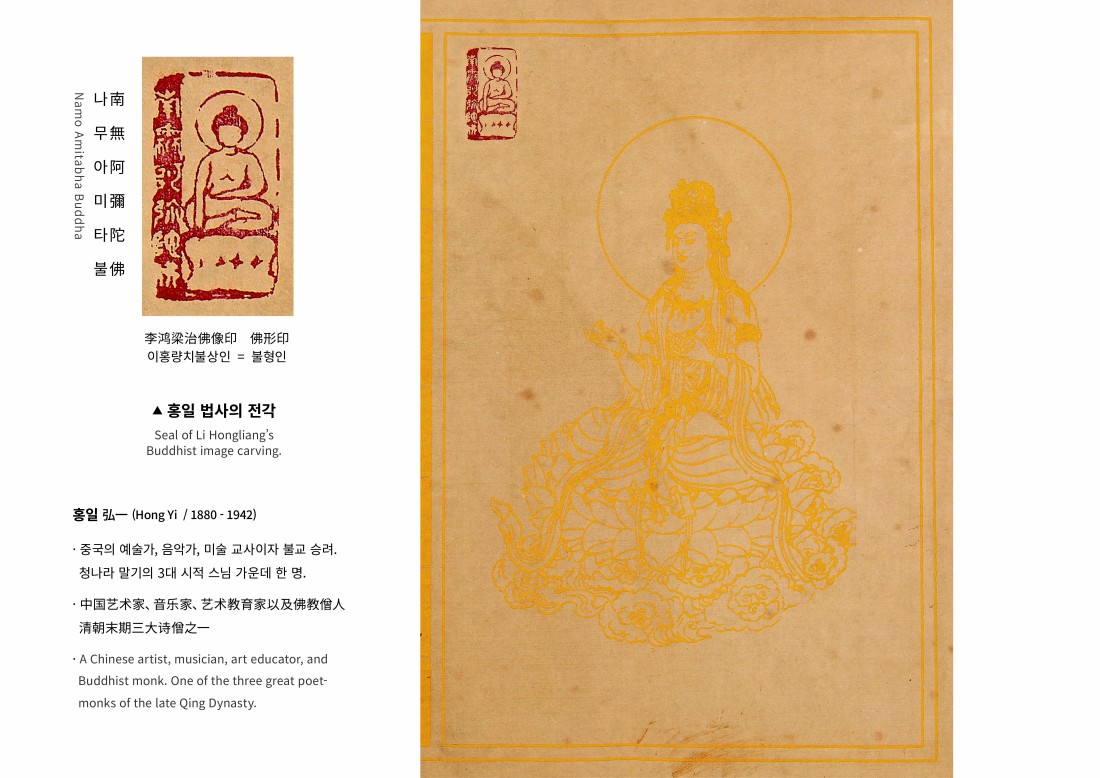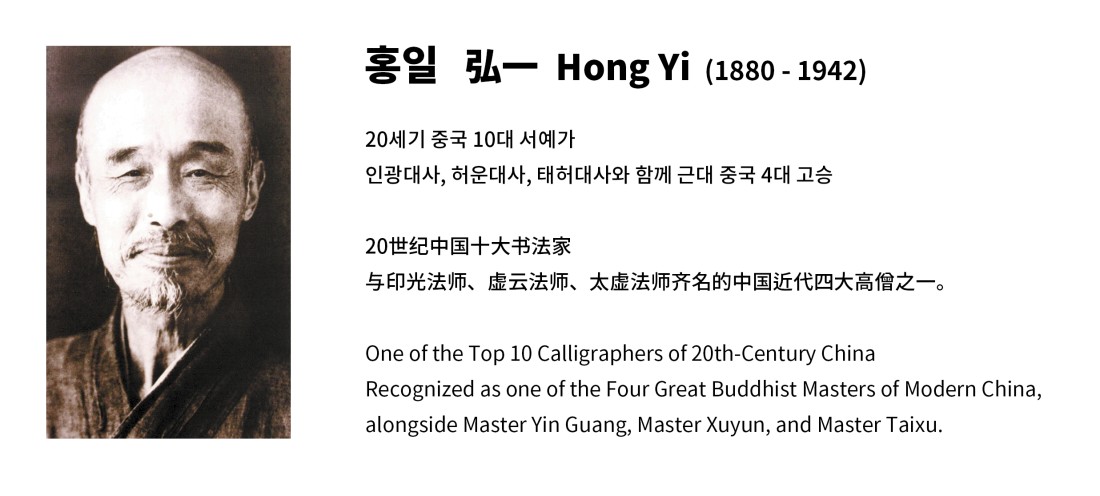본문
청나라 말기의 근대화가 황산수가 반야바라밀다심경(般若波羅蜜多心經)을 사경(寫經)한 묵서경(墨書經)입니다.
홍일 법사 (弘一, 1880-1942)의 인장과 그가 그린 것으로 추정되는 불화가 함께 있어 더욱 의미있는 유물입니다.
▣ 반야바라밀다심경 (般若波羅蜜多心經)
반야심경(般若心經)은 대승불교의 모태가 되는 총 600권 분량의 반야경을 260자로 추린 경전입니다.
반야경의 앞부분 내용은 금강경이 되고, 뒷부분 내용은 반야심경이 되었습니다. 관세음보살의 수행을 사리불(사리자)에게 말해주는 형식입니다.
현재 반야심경은 당나라 삼장법사인 현장(玄奘, 602 - 664)이 번역한 것입니다.
▣ 현장 (玄奘)
당나라 삼장법사 (602 - 664). 당나라 초기 고승이자 번역가.
태종의 명에 따라 대반야경(大般若經) 등 많은 불전을 번역했으며 ‘서유기’ 삼장 법사의 모델입니다.
▣ 홍일법사 (弘一法師) (1880~1942)
1880년, 중국 톈진에서 관공서 일을 맡던 거상(鉅賈)의 집안에서 태어났습니다.
22세에 상하이 남양공학에 입학하였고, 26세에 일본으로 유학을 떠났으며, 32세에 중국으로 돌아와 톈진공업대학에서 교직을 맡았습니다.
1916년에는 항저우 서호에 있는 정혜사(虎跑定慧寺)에 들어갔고, 1918년(39세)에 출가하여 승려가 되었습니다.
법명은 인음(寅音), 법호는 홍일(弘一)이며, 속명은 이숙동(李叔同)으로 알려져 있습니다.
그는 중국에서 최초로 서양 회화를 도입한 인물이며, 처음으로 오선지를 사용해 음악 교육을 실시한 사람입니다.
또한, 중국 최초의 화극사를 설립하는 등 예술 분야에서 선구적인 역할을 했습니다. 음악, 서예, 회화, 희극 등 다양한 방면에 깊은 조예를 지녔으며, 생애 중 50년 이상을 서예와 함께했습니다.
현대 서예가들 중에서도 그만큼 열정적으로 서예의 길을 걸었던 이는 드물며, 말년에는 자신만의 독창적인 서체를 남겼습니다.
그의 작품은 중국 서예 예술사에서 탁월한 성과로 평가받고 있습니다.
그는 모든 사람에게 '홍일 스승'으로 알려졌으며, 1942년에 복건성 천주시에서 61세의 나이로 평화롭게 세상을 떠났습니다. 홍일법사는 청나라 말기의 3대 시적 스님(시승 詩僧, 시에 능한 승려) 중 한 명입니다. (다른 사람들은 수만수, 시정간입니다)
━━━━━
这是清末近代画家黄山寿抄写《般若波罗蜜多心经》的手稿。
该作品具有重要意义,其上印有弘一法师(1880-1942年)的印章,以及推测是其所绘的佛画。
▣ 《般若波罗蜜多心经》 (简称《般若心经》)
是从大乘佛教的根本经典——《般若经》六百卷中,精炼而成的一部仅有260字的经典。
《般若经》的前半部分内容形成了《金刚经》,而后半部分内容则成为了《般若心经》。此经文以观世音菩萨的修行体悟,向舍利弗(舍利子)进行讲解的形式展开。
如今的《般若心经》是唐代三藏法师玄奘(602—664年)所译版本。
▣ 玄奘
唐代三藏法师(602年 - 664年),唐朝初期的高僧兼译经家。
他奉唐太宗之命,翻译了《大般若经》等大量佛教经典。是《西游记》中三藏法师的原型。
▣ 弘一法師 (1880~1942)
1880年出生于天津一官宦富商之家。
22岁时,他进入上海南洋公学学习,26岁时赴日本留学,32岁时回国并在天津工业大学任教。
1916年,他进入杭州西湖附近的虎跑寺,并于1918年(39岁)出家,成为一名僧侣。
法名演音,号弘一,俗名李叔同。
他是中国最早引入西洋绘画的人,也是首位使用五线谱进行音乐教学的人。
此外,他还在中国创办了第一所话剧学校等,成为艺术领域的开创者之一。
他在音乐、书法、绘画、戏剧等多个领域都有深厚的造诣,并且在生命中,有超过50年都在致力于书法。
即使在现代书法家中,像这样充满热情地走上书法之路的人也极为罕见,他在晚年创作了自己独特的书法风格。
他的作品被认为是中国书法艺术史上的杰出成就。
被人尊称为“弘一法师”,于1942年在福建省泉州市以61岁高龄安详圆寂。弘一法师是清末三大诗僧之一(另两位是苏曼殊、释敬安)。
━━━━━
This is a hand-copied manuscript of the Prajnaparamita Heart Sutra transcribed by Huang Shanshu, a modern painter from the late Qing Dynasty.
It is a particularly significant work as it includes the seal of Hong Yi Dharma Master (弘一, 1880–1942) and a Buddhist painting presumed to have been drawn by him.
▣ The Heart Sutra (般若波羅蜜多心經)
The Heart Sutra (般若心經) is an abbreviated version of the Prajnaparamita Sutras, originally comprising 600 volumes in Mahayana Buddhism, condensed into 260 characters.
The content from the first part of the Prajnaparamita Sutras became the Diamond Sutra, while the latter part formed the Heart Sutra. It is structured as a dialogue in which Avalokiteshvara (Guanzizai Pusa, 觀自在菩薩) explains his meditation practice to Sariputra (Sheiìzi, 舍利子).
The current version of the Heart Sutra was translated by the Tang Dynasty Tripitaka Master Xuanzang (玄奘, 602–664).
▣ Xuánzàng (玄奘)
A Tripitaka Master of the Tang Dynasty (602–664), a prominent monk and translator in early Tang China.
By imperial command of Emperor Taizong (唐太宗), he translated many Buddhist scriptures, including the Great Prajnaparamita Sutra (大般若經).
He is the historical figure that inspired the character of the Tripitaka Master in the classic novel Journey to the West (西游记).
▣ Hong Yi Dharma Master (弘一法師) (1880~1942)
Hong Yi Dharma Master was born in 1880 into a wealthy merchant family engaged in government affairs in Tianjin, China.
At the age of 22, he entered Nanyang Public School in Shanghai.
At 26, he went to Japan for further studies, and at 32, he returned to China to take a teaching position at Tianjin Industrial University.
In 1916, he entered Dinghui Temple (虎跑定慧寺) at West Lake in Hangzhou.
In 1918, at the age of 39, he became a monk and was given the Dharma name Yin Yin (寅音), with the monastic title Hong Yi (弘一). His birth name was Li Shutong (李叔同).
He was the first person to introduce Western painting to China and the first to use staff notation in music education.
Additionally, he established the first modern Chinese drama society, making significant contributions to the arts.
He excelled in various fields, including music, calligraphy, painting, and theater. Throughout his life, he devoted more than 50 years to calligraphy.
Few modern calligraphers have pursued the art as diligently as he did.
In his later years, he developed a unique and original calligraphic style, which is regarded as an outstanding achievement in the history of Chinese calligraphy.
He was known to everyone as "Master Hong Yi" and peacefully passed away in 1942 in Quanzhou, Fujian Province, at the age of 61. Hong Yi Dharma Master is regarded as one of the three great poet-monks of the late Qing Dynasty. (The others are Su Manshu and Shi Jingan.)
